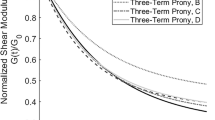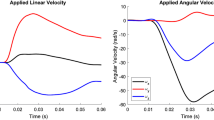Abstract
The aim of our work was to expand on the knowledge concerning mild Traumatic Brain Injuries (TBI), by combining numerical modeling and animal experiments within a joint approach. A three-dimensional finite element model of the rat brain and braincase was developed, and experimental acceleration pulses were applied. Pulse data were obtained from tests conducted using anesthetized rats, subjected to coronal plane rotational acceleration loadings of varying amplitudes and durations, aimed to generate mild TBI. Times of loss of consciousness were obtained. Biomechanical response parameters generally associated with TBI (stresses and strains) in the three anatomical regions, i.e., hypothalamus, thalamus and parietal cortex were analyzed. While the parameters correlated well with changes in injury severity linked to peak rotational acceleration, they were relatively insensitive to the pulse duration or times of loss of consciousness. As a consequence, new stress-time and strain-time metrics were computed, and these metrics were more efficient in predicting changes in injury severity associated both with acceleration characteristics and loss of consciousness outcomes in all three anatomical regions controlling the aforementioned behavior. Results of our analysis tend to show that time-related metrics may be more suited for the explanation of mild TBI than commonly used peak metrics in the three anatomical regions of the brain.












Similar content being viewed by others
References
AIS (1990) The abbreviated injury scale. American Association for Automotive Medicine, Arlington Heights, IL, p 74
Anderson RW, Brown CJ, Blumbergs PC, Scott G, Finnie J, Jones NR, McLean AJ (1999) Mechanisms of axonal injury: an experimental and numerical study of a sheep model of head impact. In: Proceedings of the IRCOBI Conference, pp. 107–120
Anderson RW, Brown CJ, Blumbergs PC, McLean AJ, Jones NR (2003) Impact mechanics and axonal injury in a sheep model. J Neurotrauma 20(10):961–974
Baumgartner D, Willinger R (2004) Human head tolerance limits to specific injury mechanisms inferred from real world accident numerical reconstruction. Revue Europeenne des Elements Finis 14(4–5):421–444
Davidsson J, Risling M, Angeria M (2009)A new model and injury threshold for sagittal plane rotational induced diffuse axonal injuries in the brain. IRCOBI York, England, pp 73–80
Deck C, Willinger R (2008) Improved head injury criteria based on head FE model. Int J Crashworthiness 13(6):667–678
Dixon CE, Lyeth BG, Povlishock JT, Findling RL, Hamm RJ, Marmarou A, Young HF, Hayes RL (1987) A fluid percussion model of experimental brain injury in the rat. J Neurosurg 67(1):110–119
Dixon CE, Clifton GL, Lighthall JW, Yaghmai AA, Hayes RL (1991) A controlled cortical impact model of traumatic brain injury in the rat. J Neurosci Methods 39(3):253–262
Faul M, Xu L, Wald M, Coronado V (2010) Traumatic brain injury in the United States: Emergency Department Visits, Hospitalizations and Deaths, Centers for Disease Control and Prevention, National Center for Injury Prevention and Control, Atlanta, GA
Fijalkowski RJ, Stemper BD, Pintar FA, Yoganandan N, Crowe MJ, Gennarelli TA (2007) New rat model for diffuse brain injury using coronal plane angular acceleration. J Neurotrauma 24(8):1387–1398
Fijalkowski RJ, Yoganandan N, Zhang J, Pintar FA (2009) A finite element model of region-specific response for mild diffuse brain injury. Stapp Car Crash J 53:193–213
Gefen A, Gefen N, Zhu Q, Raghupathi R, Margulies SS (2003) Age-dependent changes in material properties of the brain and braincase of the rat. J Neurotrauma 20(11):1163–1177
Gennarelli TA, Thibault LE, Adams JH, Graham DI, Thompson CJ, Marcincin RP (1982) Diffuse axonal injury and traumatic coma in the primate. Ann Neurol 12(6):564–574
Gennarelli TA, Meaney DF (1996) In: Wilkins NR, Rengachary S (eds) Mechanisms of primary head injury. McGraw Hill, New York, pp 2611–2621
Greenberg M (2010) Handbook of Neurosurgery. Thieme, New York, NY
Guan F, Han X, Mao H, Wagner C, Yeni YN, Yang KH (2011) Application of optimization methodology and specimen-specific finite elements models for investigating material properties of rat skull. Ann Biomed Eng 39(1):85–95
Holbourn AHS (1945) The mechanics of brain injuries. Br Med Bull 3:144–149
Kandel E, Schwartz J, Jessell T (2000) Principles of neural science. McGraw-Hill, New York, NY
King A, Yang KH, Zhang L, Hardy WN (2003) Is head injury caused by linear or angular acceleration?. IRCOBI Lisbon, Portugal, pp 1–12
Kleiven S, von Holst H (2002) Consequences of head size following trauma to the human head. J Biomech 35(2):153–160
Kleiven S (2007) Predictors for traumatic brain injuries evaluated through accident reconstructions. Stapp Car Crash J 51:81–114
Levchakov A, Linder-Ganz E, Raghupathi R, Margulies SS, Gefen A (2006) Computational studies of strain exposures in neonate and mature rat brains during closed head impact. J Neurotrauma 23(10):1570–1580
Lighthall JW (1988) Controlled cortical impact: a new experimental brain injury model. J Neurotrauma 5(1):1–15
Lindgren S, Rinder L (1969) Production and distribution of intracranial and intraspinal pressure changes at sudden extradural fluid volume input in rabbits. Acta Physiol Scand 76(3):340–351
Lissner HR, Lebow M, Evans FG (1960) Experimental studies on the relation between acceleration and intracranial pressure changes in man. Surg Gynecol Obstet 111:329–338
Luethcke CA, Bryan CJ, Morrow CE, Isler WC (2010) Comparison of concussive symptoms, cognitive performance, and psychological symptoms between acute blast-versus nonblast-induced mild traumatic brain injury. J Int Neuropsychol Soc 17(1):36–45
Macgregor AJ, Dougherty AL, Galarneau MR (2010) Injury-specific correlates of combat-related traumatic brain injury in operation iraqi freedom. J Head Trauma Rehabil 26(4):312–318
Mao H, Zhang L, Yang KH, King AI (2006) Application of a finite element model of the brain to study traumatic brain injury mechanisms in the rat. Stapp Car Crash J 50:583–600
Mao H, Gao H, Cao L, Genthikatti VV, Yang KH (2011) Development of high-quality hexahedral human brain meshes using feature-based multi-block approach. Comput Methods Biomech Biomed Eng 1–9. doi:10.1080/10255842.2011.617005
Mao H, Wagner C (2011) Material properties of adult rat skull. J Mech Med Biol 11(5):1199–1212
Margulies SS, Gennarelli T (1985) A study of scaling and head injury criteria using physical model experiments. International research council on the biomechanics of impact (IRCOBI) sitges. Spain
Marion DW, Curley KC, Schwab K, Hicks RR, The Mtbi Diagnostics Workgroup (2010) Proceedings of the military mTBI diagnostics workshop held in St. Pete Beach, August 2010. J Neurotrauma 28(4):517–526
Marmarou A, Foda MA, van den Brink W, Campbell J, Kita H, Demetriadou K (1994) A new model of diffuse brain injury in rats. Part I: pathophysiology and biomechanics. J Neurosurg 80(2):291–300
Ommaya AK, Yarnell P, Hirsch AE (1967) Scaling of experimental data on cerebral concussion in subhuman primates to concussion threshold for man. 11th Stapp car crash conference, pp 73–80
Ommaya AK, Gennarelli TA (1974) Cerebral concussion and traumatic unconsciousness. Correlation of experimental and clinical observations of blunt head injuries. Brain 97(4):633–654
Pena A, Pickard JD, Stiller D, Harris NG, Schuhmann MU (2005) Brain tissue biomechanics in cortical contusion injury: a finite element analysis. Acta Neurochir Suppl 95:333–336
Sabet AA, Christoforou E, Zatlin B, Genin GM, Bayly PV (2008) Deformation of the human brain induced by mild angular head acceleration. J Biomech 41(2):307–315
Shreiber DI, Bain AC, Meaney DF (1997) In vivo thresholds for mechanical injury to the blood-brain barrier. 41st Stapp car crash conference, pp 277–292
Shreiber DI, Bain AC, Ross DT, Smith DH, Gennarelli TA, McIntosh TK, Meaney DF (1999) Experimental investigation of cerebral contusion: histopathological and immunohistochemical evaluation of dynamic cortical deformation. J Neuropathol Exp Neurol 58(2):153–164
Shuck LZ, Advani SH (1972) Rheological response of human brain tissue in shear. J Basic Eng 94:905–911
Tagliaferri F, Compagnone C, Korsic M, Servadei F, Kraus J (2006) A systematic review of brain injury epidemiology in Europe. Acta Neurochir (Wein) 148:255–268
Vappou J, Breton E, Choquet P, Willinger R, Constantinesco A (2008) Assessment of in vivo and post-mortem mechanical behavior of brain tissue using magnetic resonance elastography. J Biomech 41:2954–2959
Winn R (2004) Neurological surgery. Saunders, Philadelphia, PA
Yoganandan N, Pintar FA, Larson SJ, Sances A Jr (eds) (1998) Frontiers in head and neck trauma: clinical and biomechanical. IOS Press, The Netherlands
Yoganandan N, Li J, Zhang J, Pintar FA, Gennarelli TA (2008) Influence of angular acceleration-deceleration pulse shapes on regional brain strains. J Biomech 41(10):2253–2262
Zhang J, Yoganandan N, Pintar FA, Gennarelli TA (2006) Brain strains in vehicle impact tests. Annu Proc Assoc Adv Automot Med 50:1–12
Zhu F, Mao H, Lineonardi A, Wagner C, Chou C, Jin Z, Bir C, Vandervord P, Yang KH (2010) Development of a finite element model of the rat head subjected to air shock loading. Stapp Car Crash J 54:211–225
Author information
Authors and Affiliations
Corresponding author
Rights and permissions
About this article
Cite this article
Lamy, M., Baumgartner, D., Yoganandan, N. et al. Experimentally validated three-dimensional finite element model of the rat for mild traumatic brain injury. Med Biol Eng Comput 51, 353–365 (2013). https://doi.org/10.1007/s11517-012-1004-7
Received:
Accepted:
Published:
Issue Date:
DOI: https://doi.org/10.1007/s11517-012-1004-7




